This is a “Not for Beginners” post. Today we’re working our way through a series of books aimed at demonstrating production sewing techniques. What we’re looking for here are the kind of shortcuts that are used in garment mass production to streamline the process, yet still produce a well-made garment. These methods allow one to put a garment together with little or no handsewing. Frequently these are exactly the opposite of the couture sewing techniques in the books we reviewed last time. (Remember that couture essentially means “custom made”.)
Professional Sewing Techniques for Designers by Julie Cole and Sharon Czachor
5th floor Main Stacks TT505 .C65 2009
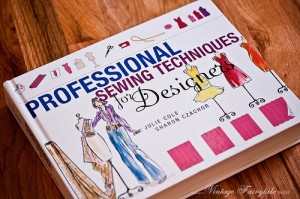 I really wanted to like this book. I first came across it at the Fashion Bookstore on 27th, across from FIT’s campus. It has a practical horizontal layout, it’s relatively new, and it seemed to cover a lot of ground in a single volume. But both Denise and I feel that it doesn’t provide the information its title promises.
I really wanted to like this book. I first came across it at the Fashion Bookstore on 27th, across from FIT’s campus. It has a practical horizontal layout, it’s relatively new, and it seemed to cover a lot of ground in a single volume. But both Denise and I feel that it doesn’t provide the information its title promises.
The first half of the book talks the reader through the process of fashion design from trend research, fabric sourcing, sketching, all the way through production, using a tone aimed at the greenest non-sewing beginner. However, the book introduces very little industry vocabulary, outside of some broad textile categories. It includes some details about tools and machines, but these are covered more clearly in other beginning how-to sewing books. It includes broad details about patternmaking and fabric properties which I would expect a student to get in more specialized classes, and in greater detail.
When this manual finally gets to “industrial” construction techniques, they are broken down by how they structure a garment, which is somewhat confusing (i.e. “Planning the Horizontal Edge”? for waist finishes) . It covers many basic sewing techniques, but the images are mostly sleek fashion illustrations that don’t convey information well, or very squared-off diagrams which aren’t color-coded as clearly as they could be. On top of being a bit too broad (in our opinions) of focus, this book is super expensive. It might be helpful as a beginning book for someone teaching him- or herself, but Denise and I both felt we’d reviewed other books that presented more information more clearly and at much lower cost. (e.g. The Reader’s Digest Guide, for starters. We keep coming back to you, oh, Reader’s Digest!)
N.B. a newer edition of this has just come out. We’ll take a look at it in a future post!
Sewing for Fashion Design by Nurie Relis and Gail Strauss
5th floor Main Stacks TT715 .R44 1997
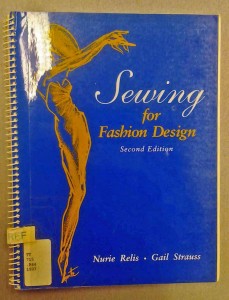 This book was written by a leading light in FIT’s Fashion Design department. She and a colleague (both long retired) were also responsible for a basic draping text that is still used “Draping for Fashion Design” with Hilda Jaffe, now newly revised. This book has solid information about mass-production sewing.
This book was written by a leading light in FIT’s Fashion Design department. She and a colleague (both long retired) were also responsible for a basic draping text that is still used “Draping for Fashion Design” with Hilda Jaffe, now newly revised. This book has solid information about mass-production sewing.
I suppose the reason I’m so comfortable with this book is that it most nearly coordinates with the information I received in my FIT classes (I’m FD ’88). Unlike the previous book, this one cuts directly to the tools of the trade, assuming you already know *how* to design. Showing its age, however, it actually still includes hand stitches, which aren’t generally used in any kind of production anymore, outside perhaps the bridal and suiting markets. Like many other books we’ve reviewed, this one includes a section describing different types of fabric. This is difficult to understand without any images, however. The most useful thing I found in this are the lists of “Summary of Assembling Procedures” (p. 72) for each sort of garment. This workflow isn’t laid out so clearly in the “professional” construction manual we’ve just discussed.
The thing that hurts this book, sadly, is that it’s all black and white and all drawings. I don’t know if this is because images were more expensive before today’s digital processing, or if, because it was a textbook, the publisher assumed a built-in audience who would buy it regardless, but it’s disappointing. Also, probably because it was originally a textbook, it seems disproportionately expensive for the amount of text it contains. Denise and I concluded that this book has some good information, but it’s not the reference text we are looking for.
Industry Clothing Construction Methods by Mary Ruth Shields
5th Floor Main Stacks and Circulation Desk TT515 .S53 2011
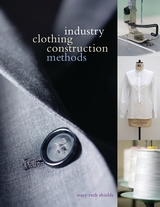 Despite being textbook-priced instead of home-sewer priced, and despite being printed in black and white, this book provides more of the information we expected to find when we began looking at books aimed at the trade. Ironically, this one states up front that it’s intended to be a textbook for a student beginning to work in the fashion industry.
Despite being textbook-priced instead of home-sewer priced, and despite being printed in black and white, this book provides more of the information we expected to find when we began looking at books aimed at the trade. Ironically, this one states up front that it’s intended to be a textbook for a student beginning to work in the fashion industry.
We both liked this book. The images in it are clear and organized so that each is near the technique described. Like the Cole & Czachor “Professional Sewing Techniques” (reviewed first in this post), this book begins with an introduction to the industry. The difference is that this book provides industry vocabulary, outlining the divisions of manufacturing, some history of recent industry changes, how the buyers and merchandisers fit in, and some up-to-date explanations of production technology. It also explains price points and classifications as well as fabric finishing and production, information that seems crucial to any understanding of fashion design as a profession. It also includes good industry profiles of designers and companies the student is probably already familiar with. I especially liked the guide to industry machinery. Many of the other books we’ve reviewed are aimed at the home sewer, but this is a really good explication of industrial processes and workflow from a manufacturer’s point of view.
This book does include sewing instructions, although they are only printed in grayscale with one color. But the instructions seem more matter-of-fact and clear, and they include the types of thread and fabrics appropriate, how to troubleshoot mistakes, and practice exercises along with the workflow flowcharts I like so much. This book may not include as varied techniques as the Cole & Czachor but it offers more concentrated doses of the information a beginner in the industry would really need. While I would still continue to refer to my “Singer Guide…” and my “Reader’s Digest…”, this seems the best focused on actual industrial methods of mass production.
The one drawback to this book is that the printing is only 2-color, so the photos are all black and white and the diagrams are all black-gray and one or two shades. The illustrations are good, but lack the clarity of some of the photography in other books we’ve liked.
Sewing for the Apparel Industry by Claire Shaeffer
5th Floor Main Stacks TT515 .S4845 2012
 This book is clearly a textbook, but the information within serves several specializations. Much of it is directed at design students, but it also includes details about industry machines and their functions. It includes order of stitching operations and production paperwork that would be more in the purview of a production manager. This is a useful and thorough book that could be a useful reference through several fashion-business and design courses. It includes instructions for working with knits, and a chapter (new, apparently) on how-to basics for beginning sewers.
This book is clearly a textbook, but the information within serves several specializations. Much of it is directed at design students, but it also includes details about industry machines and their functions. It includes order of stitching operations and production paperwork that would be more in the purview of a production manager. This is a useful and thorough book that could be a useful reference through several fashion-business and design courses. It includes instructions for working with knits, and a chapter (new, apparently) on how-to basics for beginning sewers.
Denise and I dislike the computer-generated illustrations, but they are clearer than some other books’ because they are color coded for right-side/wrong-side and the added notions. The techniques shown are workroom techniques with heavy (almost exclusively) machine stitching. This strikes me both as an excellent textbook for a fashion student, and a useful resource for the semi-professional home sewer.
Guide to Basic Garment Assembly for the Fashion Industry by Jayne Smith
5th Floor Main Stacks TT497 .S57 2013
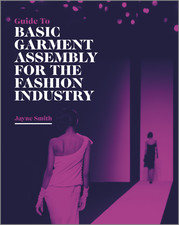 This could be a useful book for those who wish to design, but need to first acquaint themselves with the sample room. Unlike many of the others reviewed here, this is a very basic book, focused solely on production machinery and construction of basic garment parts. It covers seams, machine attachments, specialized stitches and threads, and includes a trouble-shooting section with pictures of stitch-formation problems and instructions to adjust equipment to avoid these. Unlike some of the other titles reviewed here, this book addresses only the most basic of techniques. For this reason, it would be an ideal textbook for AP 143.
This could be a useful book for those who wish to design, but need to first acquaint themselves with the sample room. Unlike many of the others reviewed here, this is a very basic book, focused solely on production machinery and construction of basic garment parts. It covers seams, machine attachments, specialized stitches and threads, and includes a trouble-shooting section with pictures of stitch-formation problems and instructions to adjust equipment to avoid these. Unlike some of the other titles reviewed here, this book addresses only the most basic of techniques. For this reason, it would be an ideal textbook for AP 143.
The most helpful thing about this book is that each photograph of a stitch or seam type includes a cross-section drawing of the layers in each operation. While it is illustrated with line drawings and photographs, many of the photos are dimly lit, or the samples shown are in muslin, which makes it difficult to determine the fabric layers in play. This is a good basic book, but, unlike some of the others, visually it is rather bland. Also, because it was published in England, all calculations are presented in metric. While this title is a basic textbook for a basic industrial design/sample techniques class, the Shaeffer book reviewed above is a more useful all-around manual that will get a student through more advanced classes as well as the first.
Garment Construction Guide, by the Union Special Corporation, Technical Training Center, Huntly, Illinois
5th Floor Main Stacks and Circulation Desk , TT520 .G27 1983
At the other end of the spectrum from beginner how-to books is this manual, produced to provide manufacturing stitchers with the stitching order for regularly-produced garments. This book is fascinating partly because it’s all diagrams and statistics, and partly because it’s so comprehensive. Each diagram shows a flat sketch of a garment. Then there are smaller drawings with arrows detailing the type of seam and seam finish for each construction detail. The Operations list that accompanies each of these sketches is a simple list of numbered instructions like “1. Make hip pocket tab” or “10. Tack label to neck opening”. Then follows some numerical information that includes the type of seam, the estimated number an operator can make in an hour, and more machine model information for each stitch.
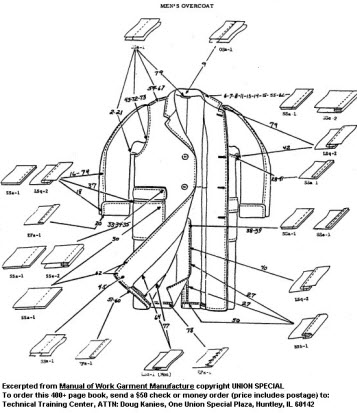 There are roughly 200 garments “exploded” like this in this manual, so that a new stitcher can understand how each garment should be produced. The second volume of this is an updated version (1997), where the illustrations are less detailed (and look computer generated) and the construction workflow instructions are listed on a “cutters must” form.
There are roughly 200 garments “exploded” like this in this manual, so that a new stitcher can understand how each garment should be produced. The second volume of this is an updated version (1997), where the illustrations are less detailed (and look computer generated) and the construction workflow instructions are listed on a “cutters must” form.
The Union Special company manufactures industrial sewing machines. This book was apparently designed as part of the training programs they set up in the early 1970s. You can find out more about their company on their website,
http://www.unionspecial.com/about-us/history/
After I’d added in this image from the more recent volume, I read in the caption that this book is still available, so we will be looking to see if there is a newer version we can add to the library’s collection.
Shirtmaking: Developing skills for fine sewing by David Page Coffin
5th Floor Main Stacks TT612 .C64 1998
Both books by David Page Coffin (see below) have great visuals. Denise and I both liked the fact that each book’s focus on a single type of garment allows the author to present more specialized construction details. Also, unlike most of the works we’ve reviewed so far, this one has menswear construction techniques. Men wear clothes too, so this seems fairer, doesn’t it? This is a great in-depth book about shirting. It includes real size patterns for multiple collar and cuff shapes as well as construction techniques only applicable to . Denise didn’t care for some of the line drawings (illustrating proper fit and how to drape from scratch), but the construction sections show clear step-by-step instructions. The volume also addresses different fitting and shaping options, and includes directions for “rubbing off” a pattern from a shirt you already have. Unfortunately, this book relies more heavily on line drawings than on photos, but the author clearly has taken advantage of newer publishing resources by the time he produced the next book below.
Making Trousers for Men and Women: A Multimedia Sewing Workshop by David Page Coffin
5th Floor Main Stacks TT605 .C65 2009
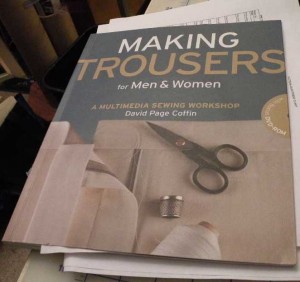 David Page Coffin’s more-recent book on pants is everything Denise and I want in an instructional book: It has color illustrations that are coded to make fabric layers clearer. It also has more well-photographed sequences for each instruction, broken down and labeled clearly for the less-experienced stitcher. The difference between these two volumes (this and the shirts volume above) is noticeable. We hope that each publication from him will continue this trend. And if you enjoy making pants, we highly recommend this book!
David Page Coffin’s more-recent book on pants is everything Denise and I want in an instructional book: It has color illustrations that are coded to make fabric layers clearer. It also has more well-photographed sequences for each instruction, broken down and labeled clearly for the less-experienced stitcher. The difference between these two volumes (this and the shirts volume above) is noticeable. We hope that each publication from him will continue this trend. And if you enjoy making pants, we highly recommend this book!
High Fashion Sewing Secrets from the World’s Best Designers by Claire B. Shaeffer
5th floor Main Stacks TT515 .S484 1997
 This book is neither fish nor fowl. It contains more finishing techniques than the couture-handwork books we reviewed last time. Most of the techniques included here are machine-done, but they still represent better garment techniques that an ambitious home sewer might want to incorporate into his or her work. The illustrations are clear, with color clearly designating layers and photographs of finished garments incorporated. I like the way this book is laid out. I just don’t know if it expands sewing knowledge in a unique way. Much of the information is duplicated elsewhere, although it’s all done very well here. The target audience is still a home sewer using a pattern, although instructions are included to augment a pattern as needed (such as how to draft a lining pattern from a jacket). If I had to choose books, I probably would leave this one out of my purchasing plans, even though the material is well presented, because I have most of the techniques listed in other, more comprehensive books.
This book is neither fish nor fowl. It contains more finishing techniques than the couture-handwork books we reviewed last time. Most of the techniques included here are machine-done, but they still represent better garment techniques that an ambitious home sewer might want to incorporate into his or her work. The illustrations are clear, with color clearly designating layers and photographs of finished garments incorporated. I like the way this book is laid out. I just don’t know if it expands sewing knowledge in a unique way. Much of the information is duplicated elsewhere, although it’s all done very well here. The target audience is still a home sewer using a pattern, although instructions are included to augment a pattern as needed (such as how to draft a lining pattern from a jacket). If I had to choose books, I probably would leave this one out of my purchasing plans, even though the material is well presented, because I have most of the techniques listed in other, more comprehensive books.
If you’ve read this far, you are a tough-minded individual who *really* enjoys sewing! We’re going to stop for now, and wish you a good few weeks. We’ll keep on reviewing our (HUGE) how-to collection, we promise. But for now, we’ll let your eyes rest a bit.
Talk with you soon, Beth and Denise
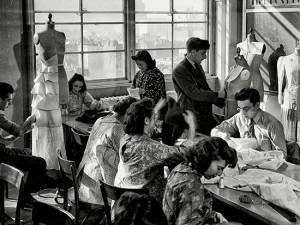
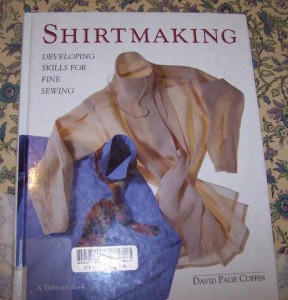
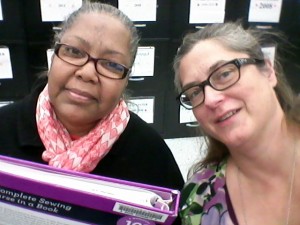
Comments
2 responses to “Needles in the Stacks: Professional Sewing Techniques edition”
[…] http://blog.fitnyc.edu/volumesandissues/2014/06/17/needles-in-the-stacks-professional-sewing-techni…. ) […]
[…] a lot of important basic construction techniques. It’s maybe not as complete as, say, the Claire Shaeffer guide to sewing for the industry, or the “DK Complete Book of” (see above), but is a lot friendlier and faster to […]